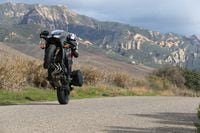The road away from our hotel in Ojai, California was punctuated with speed bumps, and as soon as I rolled over the first one I discovered that the FJ-09’s suspension was better, too. I’d sat through the FJ’s technical presentation the previous night and learned that Yamaha had the makings for an excellent middleweight mile eater, but the whole time I was thinking that if the fueling and suspension weren’t fixed, none of the other stuff would matter. I was both relieved and pleased to learn that the FZ’s shortcomings had been remedied.
The FJ-09 has the same torquey and charismatic 847cc triple as the FZ-09 as well as the same frame, exhaust, wheels, and suspension, but Yamaha didn’t just throw a windscreen on the naked bike and call it good. The list of additions is long: From front to back the bike has new LED headlights, new bodywork, an adjustable windscreen, hand guards, an Ténéré-style dash and switch clusters, a larger tank, an adjustable seat, a center stand, and traction control and ABS, among other things.
The riding position is totally revised with an eye towards comfort. A wider handlebar is positioned closer to the rider and sits atop taller stalks (that can be reversed to move the bar 10mm forward), and the new seat is both flatter and taller than the FZ’s so there’s more legroom and less of a tendency to slide forward against the tank. The FJ’s subframe is a full 5 inches longer than the FZ’s, to provide more room for the rider and passenger and to accommodate the accessory hard cases, which were fitted to all of the test bikes. The bikes were also equipped with optional heated grips, which proved their value during the cold, damp test ride through the mountains and along the coast of Santa Barbara.
To fix the FZ-09’s flaccid suspension, Yamaha more than doubled the damping in the shock and increased both compression and rebound damping in the fork significantly. As one Yamaha test rider put it, the FJ-09 suspension has “heavily revised internals.” Yeah. The shock spring is the same as before, but the fork springs are now progressive units, with softer initial rates and firmer final rates.
On the road, the bike feels worlds better than the FZ-09. Ride quality is actually quite good, with the FJ’s suspension erasing small bumps and taking the edge off bigger hits. On the freeway and during the gentle, flowing back-road riding we did during the morning, the chassis felt fluid and composed. But once the roads dried and the throttle and brakes were used more aggressively, the FJ’s chassis got flustered. The shock and fork springs are still quite soft so there’s still a lot of suspension movement, but overall that movement is far more controlled than the FZ-09’s. It’s a definite improvement and a good match for this bike’s mission as a sporty long-distance machine.
So riders can cover more distance, Yamaha increased the FJ’s tank 1.1 gallons to 4.8 gallons. There were 175 miles on the trip meter when we got back to the hotel and one bar showing on the fuel gauge. I’ve averaged about 38 mpg over the last 7,000 miles on my long-term FZ-09, so it’s safe to assume that the FJ will go about 180 miles between fill-ups, which should satisfy most riders. Mileage, fuel consumption, and other data are easily monitored via the new dash.
I suspect that most riders will have no complaints about the way the FJ-09 responds to throttle inputs. Yamaha says the ride-by-wire throttle mapping was “tailored to sport-touring type riding,” which is to say it has smoother, gentler response. In Standard mode response is pretty refined, though there’s still a hint of abruptness off closed throttle at small throttle openings and low rpm. The more aggressive A mode is still a bit too twitchy for low-speed work, but at higher rpm it’s great and grants greater access to the triple’s awesome power. Model-year 2015 FZ-09s will have similarly updated mapping, and Yamaha has an ECU reflash for 2014 FZ-09s that’s said to be a big improvement over the stock maps. I’m glad Yamaha is addressing this issue.
The small fairing, hand guards, and windscreen do a good job of warding off the wind, and effectively kept my legs, torso, and hands dry in the rain. The windscreen is adjustable, but only by 30mm and the adjustment procedure is none too convenient. Just leave it in the highest position for maximum coverage and minimal buffeting. Overall the FJ is a comfortable ride, and with its smooth-spinning engine it should prove to be a very capable long-distance machine. If only Yamaha had fitted it with cruise control. Maybe for the 2016 model.
Switchable traction control and ABS are standard on the FJ-09. Responses are coarse but effective and they don’t butt in prematurely. I turned off the traction control and was satisfied with the wet grip offered by the Dunlop D222s, which were fitted to the FJ to provide better wear resistance. In terms of power, this bike has all the oomph and vigor of the FZ-09, and is quite a bit more athletic than bikes like BMW’s F800GT, Honda’s Interceptor, Kawasaki’s Versys 1000 and Ninja 1000, and Suzuki’s V-Strom 1000.
Compared to those other bikes, the FJ-09 is just as versatile and far more affordable. At $10,490, this is a bargain buy, and its strong, rev-happy engine gives it a much livelier character than anything else in the segment. We’ll compare the FJ-09 to its competitors shortly, but in the meantime, if you’ve been waiting for a more composed, more comfortable FZ-09, this is your bike.





















/cloudfront-us-east-1.images.arcpublishing.com/octane/G4MG6OUCJNBSHIS2MVVOTPX65E.jpg)
/cloudfront-us-east-1.images.arcpublishing.com/octane/IIGGWFOTOJGB7DB6DGBXCCMTDY.jpg)
/cloudfront-us-east-1.images.arcpublishing.com/octane/QSTCM6AVEZA5JJBUXNIQ3DSOF4.jpg)
/cloudfront-us-east-1.images.arcpublishing.com/octane/U4I7G625B5DMLF2DVIJDFZVV6M.jpg)
/cloudfront-us-east-1.images.arcpublishing.com/octane/B6XD6LS6IVCQPIU6HXDJSM3FHY.jpg)
/cloudfront-us-east-1.images.arcpublishing.com/octane/ICL63FEDDRDTTMINYICCEYGMDA.jpg)
/cloudfront-us-east-1.images.arcpublishing.com/octane/FCGZHQXRBZFLBAPC5SDIQLVF4I.jpg)
/cloudfront-us-east-1.images.arcpublishing.com/octane/WNOB6LDOIFFHJKPSVIWDYUGOPM.jpg)

/cloudfront-us-east-1.images.arcpublishing.com/octane/X33NU3E525ECRHXLNUJN2FTRKI.jpg)
/cloudfront-us-east-1.images.arcpublishing.com/octane/6KKT5NNL2JAVBOXMZYS5ZO76YA.jpg)
/cloudfront-us-east-1.images.arcpublishing.com/octane/J5RKG5O455GMPGQRF2OG6LRT7A.jpg)
/cloudfront-us-east-1.images.arcpublishing.com/octane/GX2CIZKQVRH2TATDM26KFG2DAE.jpg)
/cloudfront-us-east-1.images.arcpublishing.com/octane/ZWIDYSAKQZHD5BHREMQILXJCGM.jpg)
/cloudfront-us-east-1.images.arcpublishing.com/octane/CYUHJZCTSJCH3MRAQEIKXK7SCQ.jpg)
/cloudfront-us-east-1.images.arcpublishing.com/octane/LKOFINY56FCXJCANJ5M7ZDQUBY.jpg)
/cloudfront-us-east-1.images.arcpublishing.com/octane/4NBPDACMWJH63JQYJVK3QRBDZI.jpg)
/cloudfront-us-east-1.images.arcpublishing.com/octane/KKHQHRR3FJGX7H2IPU6RALMWG4.jpg)

/cloudfront-us-east-1.images.arcpublishing.com/octane/5IOFS5JAE5FOXMNA23ZRAVVYUU.jpg)
/cloudfront-us-east-1.images.arcpublishing.com/octane/CGXQ3O2VVJF7PGTYR3QICTLDLM.jpg)

/cloudfront-us-east-1.images.arcpublishing.com/octane/OQVCJOABCFC5NBEF2KIGRCV3XA.jpg)
/cloudfront-us-east-1.images.arcpublishing.com/octane/OPVQ7R4EFNCLRDPSQT4FBZCS2A.jpg)